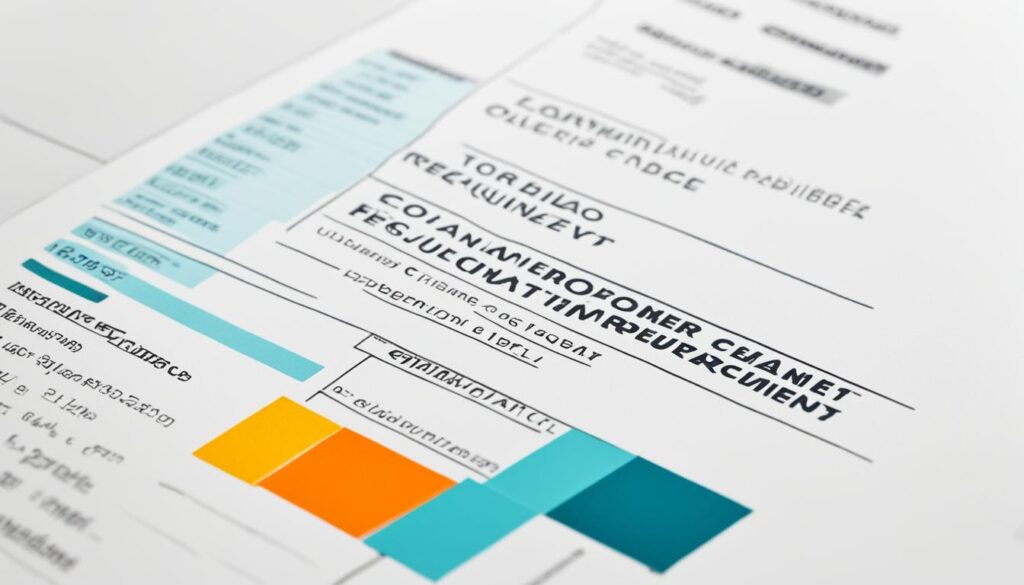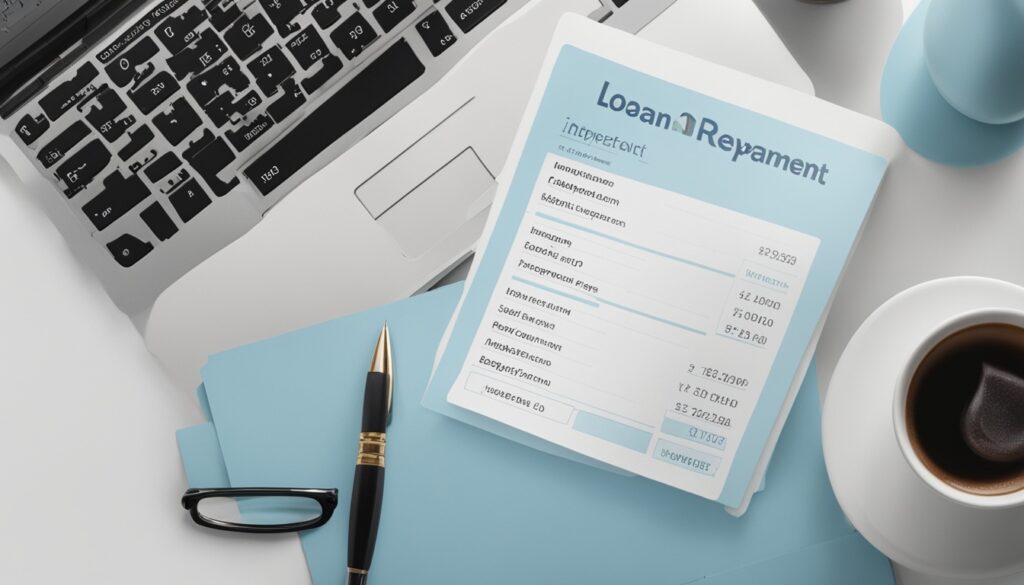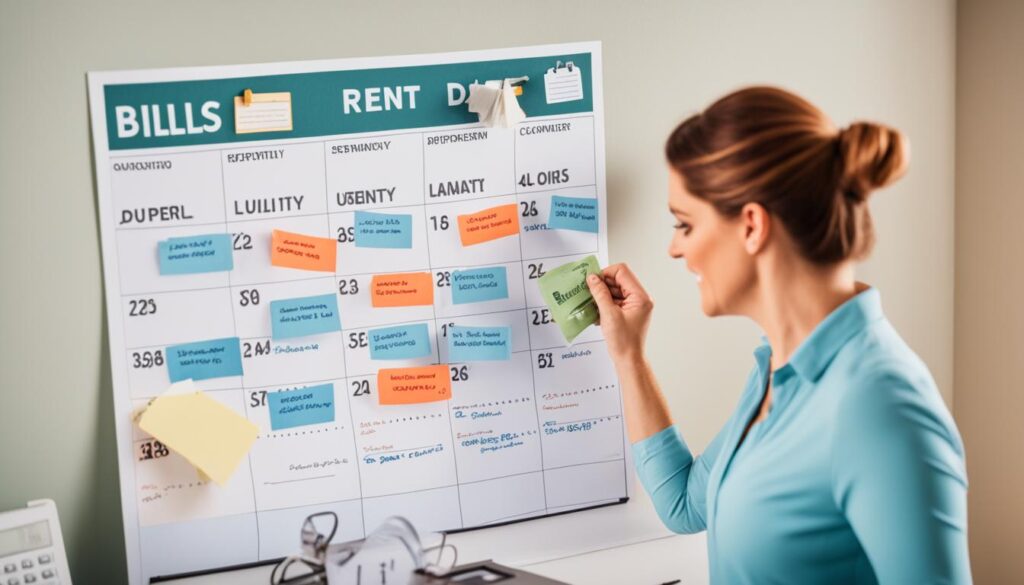Looking for a personal loan? There are steps to take that can make things smoother. Check your credit score first. Make it better if you can. Next, figure out your monthly payments to see what you can manage. Then, shop around to compare lenders. Find one that meets your needs.
Key Takeaways:
- Check your credit score before applying for a personal loan. A higher credit score increases your chances of loan approval and better interest rates.
- Calculate your loan payments to ensure you can afford the loan. Consider the loan amount, interest rate, and loan term to find a loan that fits within your budget.
- Research and compare lenders to find the best personal loan options. Look for competitive interest rates, flexible repayment terms, and good customer reviews.
- Understand the loan requirements of each lender. Make sure you meet the eligibility criteria and have all the necessary documents and information ready.
- Complete the loan application accurately and provide all required documentation. Be prepared to answer additional questions or provide further documentation if requested by the lender.
Check Your Credit
Before you apply for a personal loan, check your credit score. Lenders look at your score to judge if you’re trustworthy with money. A high score boosts your chance of getting a loan and a lower interest rate. So, know your score and work on improving it.
First, get a copy of your credit report. Visit major credit agencies like Equifax, Experian, or TransUnion to check it. Make sure everything in the report is correct. If you see a mistake, report it to the right agency.
It’s key to always pay your bills on time and in full. Bad payment history hurts your credit score. So, don’t miss payments to keep your credit healthy.
If your credit score is low, don’t panic. There are ways to boost it. Pay off debts, especially on credit cards. Lowering your total debt helps your score. Also, try not to get more loans or credit cards right now.
Checking and fixing your credit can help you get better loan terms. When you know your credit is good, applying for loans becomes easier. Work on your credit, and loans will be more accessible to you.
Calculate your Loan Payments
It’s vital to know your loan payments when you take a personal loan. This ensures it’s a good fit for your budget. By calculating your payments, you’ll see how much you can borrow safely.
First, figure out how much you need to borrow. Include any fees or extra costs. This gives you the total amount you’ll need for the loan.
Next, look at the interest rate. Your credit score affects this rate. A good score means a lower rate, which is good for payments.
Also, consider how long you have to repay the loan. Longer times may lower your monthly payments but mean more total interest. Shorter times can raise your payments but save you money on interest overall.
Using an online loan calculator is a simple way to figure out payments. It quickly tells you the monthly cost. This way, you can see if the loan fits within your budget.
It’s important to calculate your payments before getting a loan. It helps you avoid financial trouble. By looking at loan amount, rate, and term, you can make smart choices.
A $10,000 loan needs careful thought. Including fees, you might need $10,500. Let’s say you get a 5.5% interest rate with two term options. A 3-year loan means $315 monthly, and a 5-year term is $202 monthly.
As seen, a 3-year term costs more each month but is cheaper overall. Choose based on what’s best for your finances and goals.

Research and Compare Lenders
When you need a personal loan, it’s smart to look at different lenders. This helps you find the best deal. Exploring your options can save you a lot of money and give you better loan terms. It’s like shopping around to get the best price on a product.
When comparing lenders, here’s what you should look at:
Interest Rates
Interest rates are a big deal in loans. A lower rate means you pay less each month and over the life of the loan. Try to find lenders with the best interest rates.
Repayment Terms
The repayment terms’ flexibility is also important. Some lenders let you pick how long or short your loan is. It’s crucial to choose what fits your budget and plans.
Customer Reviews
Reading customer reviews can tell you a lot about a lender. They show you how well a lender treats its borrowers. Look for lenders that people seem happy with.
Credit Score Requirements
Lenders have different rules about your credit score. If yours isn’t great, look for lenders used to helping people like you. This can help make getting a loan more likely.
Loan Options
There are many types of loans. Think about if you want it secured, fixed-rate, or a certain amount. Consider what you need and see if the lenders have those options.
Be sure to compare important things like interest rates and fees. Also, check the lenders’ reputation. This will help you pick the right personal loan lender.
Understand Loan Requirements
Before you apply for a loan, know what the lender needs. Each lender has their own rules for who can get a loan. If you understand and meet these rules, you can get through the process faster and easier.
Here are some things lenders often ask for:
- A valid social security number: You usually need this to confirm your identity and check your credit.
- Minimum age requirement: You need to be 18 or older to get a personal loan.
- Minimum income: Lenders want to make sure you earn enough to pay back the loan.
- Physical address: They also need your address to register where you live.
Make sure to look at what the lender asks for in their application. If you get all your documents ready and meet their criteria, you can speed up getting your loan.
Quote:
“Understanding the loan requirements is crucial before applying for a personal loan. By fulfilling the lender’s eligibility criteria and preparing the necessary documentation, you increase your chances of loan approval and a smooth application process.”

Gather Required Documentation
When you want a personal loan, it’s key to have all needed documents ready. This makes getting approved faster and easier. Your loan process will be much smoother.
Lenders expect certain papers to check your readiness and financial health. You’ll need to show:
Proof of Income
Proof of income is crucial. You can use pay stubs, bank statements, or taxes. This shows you can repay the loan on time. It helps your application stand out to lenders.
Proof of Identity
Showing who you are is important. Use a driver’s license, passport, or state ID. This proves you’re really you.
Proof of Address
Lenders also need to see where you live. Use utility bills or bank statements. They show your current address clearly.
Keep these documents in order and close by. It will cut down on the time it takes to apply for your loan.
| Required Documentation for a Personal Loan Application | |
|---|---|
| Proof of Income | Pay stubs, bank statements, tax returns |
| Proof of Identity | Driver’s license, passport, state ID |
| Proof of Address | Utility bills, lease agreements, bank statements |
Having these documents ready helps a lot. It speeds up the approval process. It also shows lenders you are ready and well-prepared. Always check what else your lender might need for your specific loan.
Complete the Loan Application
It’s time to fill out the loan application now. Gathering all your documents was just the start. This step is important for getting a personal loan. You need to be careful and provide true information about yourself and where you work.
First, write down your name, where you live, and how to contact you. Make sure everything is correct. Mistakes can slow down how quickly you get your loan. Your personal information like your address is crucial to your application. It helps the lender to find you if they need to.
Next, you need to include your job info. That means your employer’s name, where they are, and how to reach them. Don’t forget to say what you do at work and how long you’ve been there. The right work details show the lender you have a job and you earn money. This is key for them to see if you can pay back the loan.
Now, tell them about your money. How much you make each month or year. If you earn money from other places, tell them that too. The lender wants to know if you can afford to pay back the loan. So, telling them everything about your income is very important.
Always tell the truth when you’re filling out this application. Giving wrong information about yourself or your job can cause problems. You might not get the loan. And there could be legal issues. If the lender asks for more information, be ready to give it.
Filling up the loan form correctly and completely helps you get the loan. Everything from applying to getting your money goes more smoothly. And it makes the lender’s job of checking your application easier too.
Example Loan Application Form
| Personal Information | Employment Details |
|---|---|
| Name: [Your Full Name] | Employer’s Name: [Company Name] |
| Address: [Your Home Address] | Employer’s Address: [Company Address] |
| Contact Details: [Phone Number, Email Address] | Job Title: [Your Job Title] |
| Income Information: [Monthly/Annual Income] | Length of Employment: [Years/Months] |
Wait for Loan Approval
After sending your loan application, waiting for approval is the next step. The lender will check your application closely. They look at the information you gave and review your credit to see if you qualify.
The time it takes to process your loan can differ. It might be quick or it might take a while. Remember, it’s best to avoid sending many applications at once. Doing that can hurt your credit.
If the lender asks for more documents, do your best to get them to them fast. This can stop any delays in getting your loan approved.
Credit history, income, and financial health all play a role in getting your loan approved. The lender needs to ensure you can pay back the loan safely.
While waiting, it’s wise not to change your finances a lot. Avoid new debts or big purchases. These could make the lender worry about giving you a loan.
When your loan is approved, the lender will send you the details. This includes the interest rate, how and when to pay back, and any fees. Take time to understand and review these details carefully.
If you don’t understand something about the loan, ask the lender for help. It’s vital to get the loan agreement clearly before you accept. Understand everything to move forward with the loan.
Summary Table: Loan Approval Process
| Step | Description |
|---|---|
| 1 | Submit your loan application to the lender. |
| 2 | The lender reviews your application, verifies your information, and assesses your creditworthiness. |
| 3 | The lender may request additional information or documentation for underwriting purposes. |
| 4 | Be patient as the lender processes your application, as it may take several days to weeks. |
| 5 | Review the loan terms and conditions provided by the lender. |
| 6 | Contact the lender if you have any questions or concerns about the loan agreement. |
| 7 | Accept the loan offer if you’re satisfied with the terms and conditions. |
| 8 | Wait for the loan funds to be disbursed to your account, typically within the next business day. |
Review Loan Terms and Conditions
After your loan application is accepted, the lender will send you the terms and conditions. Make sure to read these documents carefully. This will help you fully understand the loan and its conditions.
The interest rate is a crucial point to look at. It’s what the lender charges on the money you borrow. A lower rate means less money spent on interest. So, it’s good to keep the interest rate as low as possible.
Understanding the repayment schedule is also key. This schedule shows when and how much you need to pay. Knowing these dates helps avoid late fees. So, know your repayment dates well.
Other charges, such as origination fees and penalties, are also in the document. You need to be aware of these fees. It’s important for planning how you’ll pay back the loan.
If there are terms you don’t get, ask the lender. It’s vital to understand everything before you agree to the loan.
Benefits of Reviewing Loan Terms and Conditions:
- Ensuring you understand your financial obligations
- Identifying any hidden fees or charges
- Comparing loan terms with other lenders
- Making an informed decision regarding the loan offer
By carefully reading the loan terms and conditions, you make a choice that’s right for you.

Loan Terms and Conditions Checklist:
| Key Details | Questions to Consider |
|---|---|
| Interest Rate | Is the interest rate fixed or variable? Is it competitive compared to other lenders? |
| Repayment Schedule | What are the repayment dates and amounts? Are they manageable within your budget? |
| Fees and Charges | Are there any additional fees or charges? How do they impact the overall cost of the loan? |
| Prepayment Penalties | Are there any penalties for paying off the loan early? Can you make extra payments without incurring fees? |
| Grace Period | Is there a grace period before repayment begins? If so, how long is it? |
Reading the loan terms and asking the right questions is important. This ensures your decision is the best one for you.
Accept the Loan Offer
After looking over the loan’s terms and conditions, it’s time to decide. If the terms work for you, go ahead and accept the offer. This usually means signing electronically or following the lender’s instructions. Make sure you fully understand the terms and what they mean for your finances. By saying yes, you’re ready to move forward with the loan.
Once you say yes to the loan, the lender starts the process to send you the money. The loan amount will go into your bank account. When you get the money can change based on the lender and other things. But usually, it arrives the next business day after you accept. Always check your bank info is right. This can help you avoid any hold-ups.
Repay the Loan
Once you get the loan money, it’s key to repay on time. Here’s how to make it easier:
- Figure out how much and how often you’ll pay each month. This helps you plan your budget to avoid late payments.
- If you can, set up auto payments. They keep you on schedule and prevent late payments.
- Check your loan balance often to see how you’re doing. It helps you know what’s left and if you need to adjust your plan to pay back quicker.
Paying on time is vital for good credit and avoiding fees. Stay organized and you can clear your loan without trouble.
Now, look at the table below. It shows various ways to pay back your loan:
| Payment Option | Key Features |
|---|---|
| Traditional Monthly Payments | Fixed monthly payments over the loan term |
| Biweekly Payments | Payments made every two weeks, creating an extra payment each year |
| Accelerated Payments | Paying more each month to finish the loan early |
| Interest-Only Payments | Paying just the interest for a set time |

Conclusion
A personal loan can be a big help for many things we need. If you want to get one, you should do a few things first. Check your credit, find out what your payments will be, look at different lenders, and learn what they need from you. Doing all this will make getting a personal loan easier and more successful for you.
Start by looking at your credit score. If it’s not great, try to improve it. This can help you get your loan approved. It might also mean you pay less interest.
It’s important to know how much you can pay each month. This will show you the right amount of loan to apply for. Then, shop around for different lenders. Compare their offers and choose the best one for you. Make sure you know what they ask for. Have all the documents they need ready. This makes the loan application process go smoothly.
Following these steps means you’ll be in control every step of the way. Remember, getting a personal loan is not just about the money. It’s about managing your future well.
FAQ
How important is it to check my credit before applying for a personal loan?
Checking your credit score before you apply for a personal loan is crucial. Lenders look at your score to see how reliable you are at repaying. A high score improves your chances of getting a loan approved. It can also mean you get a lower interest rate.
How do I calculate my loan payments?
To calculate your loan payments, first figure out how much money you need. Add any fees the lender charges to this amount. Based on your credit score, make an educated guess about the interest rate you might get. Think about the length of time you want to pay back the loan.[//p]Use an online calculator to work out your monthly payments. This will help you see if the loan fits your budget.
How do I research and compare lenders?
Research and compare lenders to find the best match for you. Look for competitive interest rates and flexibility in the repayment terms. Also, consider what people say about them in customer reviews. Pay attention to their credit score requirements and the variety of loan amounts and terms they offer. This will help you get the best loan deal.[//p]
What are the common requirements for a personal loan?
To get a personal loan, you usually need a valid social security number and be 18 or older. You have to meet a minimum income and have a fixed address. Different lenders may have specific conditions. So, always check their requirements before applying.
What documents do I need to gather before applying for a personal loan?
Before you apply, gather important documents. You’ll need to prove your income with pay stubs or tax returns. Also, bring identification, such as a driver’s license. And don’t forget something to show where you live, like a utility bill. Having these ready will speed up the application process.
What information do I need to provide when completing the loan application?
When filling out the loan application, provide correct personal info, like your name and address. You also need to share your work details, including your employer’s name and how much you make. If the lender needs more information, be ready to provide it.
How long does it take for a personal loan to be approved?
The approval time for a personal loan varies. It can take from a few days to a couple of weeks, depending on the lender. During this time, they will check your application and your credit. Be ready to send extra info if they ask.
What should I review before accepting a loan offer?
Before saying yes to a loan, carefully read the terms and conditions. Focus on the interest rate and how you’ll pay back the loan. Also, be aware of any extra fees. If you’re not sure about something, ask the lender to explain before you accept the loan.[//p]
How do I start making repayments on my personal loan?
After you get the loan, it’s time to start paying it back. Figure out how much and how often you’ll make your payments. If possible, set up automatic payments. This can help you avoid missing due dates. Stay on top of your loan by keeping track of your balance and how much you’ve paid.[//p]
How can I secure a personal loan that suits my needs and financial situation?
Following the steps in this guide can help you through the loan process. Check your credit score and work out your payments. Research different lenders to find a good match. Understand what each lender needs from you. By staying informed and taking action, you can find a personal loan that’s right for you.



















